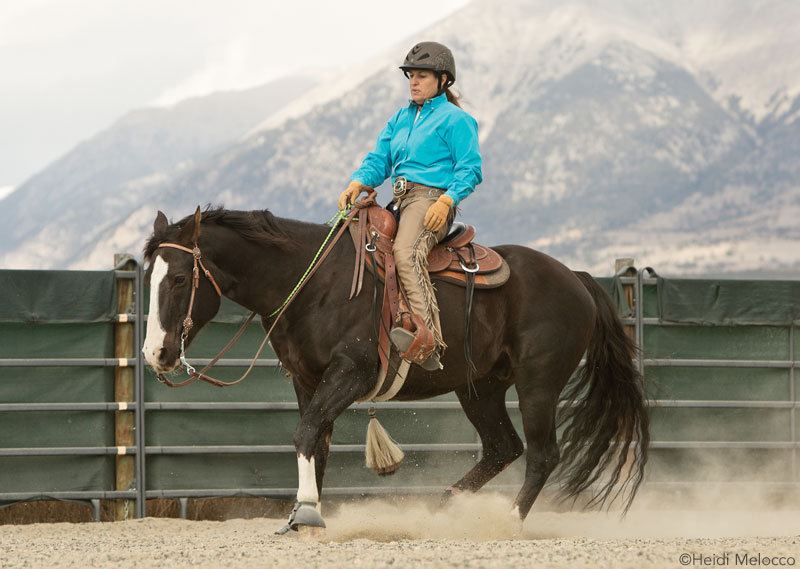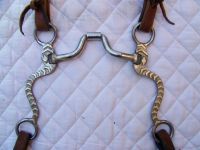Are you ready to take off the bridle? Before you do, you must be absolutely certain you can maintain safety, as well as obedience in your horse. Riding without a bridle shows that you and your horse have refined your cues, built up trust and respect, and have a great partnership.
Read part one of Julie Goodnight’s Bridleless Series >>
Read part two of Julie Goodnight’s Bridleless Series >>
If you have worked on the skills covered in the first two installments of this series, you should have a horse that never challenges you on direction or speed. You have developed new cues for your horse to turn, stop and back up that don’t involve the reins. Through consistent cueing and timely reinforcement with the reins, your horse has learned to listen to what you’re saying with your body cues.
Even if you’ll never take off your horse’s bridle, learning to give cues with your entire body (not just your reins) will make you a better rider. Holding your horse accountable for his actions will increase his respect for your authority. Following this plan with your horse is worthwhile with or without the bridle.

Riding bridleless is a major challenge for you and your horse, and it could easily take more than a year before you are ready to take off the bridle. This series has given you a plan to follow—how long it takes you to get there is up to you and your horse. But with each and every step you accomplish, you will be a better rider and your horse will be a better partner.
When you think you and your horse are ready to take the final step, it’s time to test his obedience and responsiveness through a systematic process. You need to find out how easy he is to control with a neck rope before you drop the bridle.
Who’s in Charge?
First, be sure that you are testing your horse’s readiness for bridleless work and that he isn’t the one testing you. If you’ve been working on the previous steps for some time and your horse is not yet obedient—he’s still challenging the speed and direction that you ask for—something may be inherently wrong in your relationship. You’ll need to analyze all of your interactions with your horse and be willing to go back to groundwork to establish leadership in all areas.
If your horse doesn’t accept your authority, he doesn’t see you as the leader. So take an honest look at your relationship and figure out what you are doing to erode your own authority over the horse. Seek the help of an experienced horse person if you feel you’re being tested.
If you’re still struggling with your new cues to stop, turn and control speed, you’re probably not clear and consistent in your cues, or you aren’t using adequate reinforcement (timing and/or pressure). It’s likely both of these things. This means you need to work on improving your riding skills, clarifying your cues and using more effective reinforcement.
Testing
If you feel satisfied that your horse is obedient and responsive to your hands-free cues, you are ready for a test. Outfit your horse in his usual tack and bridle. Secure your reins by tying them to the horn or hooking them to your saddle with a string. Make sure that your reins are very loose so that your horse has to listen to your body cues for directions. The reins are only there as a backup at this point—not as your go-to aid.
Position yourself exactly as you would if you were riding with the reins in both hands in an equitation class. Your horse needs that consistency in your position and the way you move your body. Even though your hands are not connected in any way to the reins, you’ll still use them exactly as if they were, and you will gesture with your hands and arms to help your horse find the cue that is coming from your body.
Remember, bridleless cues are much harder for your horse to understand and follow; he has to pay much closer attention to you and always be alert. This is not easy for most horses and downright hard for others. Help him as much as you can by making sure you have his attention. Tap on his neck and say, “Hello, are you there?” When he does listen well, make sure to praise often.
Ride him around in easy patterns at the walk. Practice steering and walk- and trot-to-halt transitions. See if he will respond to your backup cue. Stick with the walk until you are very confident in his responses, and then progress to the trot. Reach down and reinforce with the reins as needed, and never allow the horse to ignore you.
Practice this for a few days or weeks, ideally at the end of your usual workout. Only practice when your horse is trying hard to listen to you—set him up to be successful. When he listens well, praise him and put him away. He will come to look forward to the reinless work to show how good he can be; he’ll work hard in the hopes you will then put him away.
Once your horse is responding well with the reins tied up, you have already accomplished the hardest part of riding bridleless. You only have one more easy step before you are ready to ride sans bridle, and that is to see how well your horse responds to a neck rope.
A neck rope will help you cue the horse when the bridle is off. It helps you to get his attention and alert him to a cue. It also gives you a backup plan if something goes wrong.
Riding With a Neck Rope
With your reins attached and tied up (but loose so they are not affecting your horse), ride with a neck rope and continue to practice your bridleless cues to turn and stop. Ride with the neck rope at the walk, trot and lope, doing lots of turns and transitions, until you are confident it works as well as the bridle. Try not to trade in your reins for the neck rope though. Continue to cue with your body and only use the neck rope for reinforcement.
Depending on how far you have come with your horse, it may take five minutes or five days in this pre-bridleless testing phase. If he isn’t passing the test with flying colors, go back to the beginning and work on your foundation. Analyze your relationship and your riding skills to see where things are going wrong. When you feel like your horse is responding well to your rein-free cues and you feel confident that the neck rope gives you control if he doesn’t respond, then it’s time to take off the bridle.
Your First Time Bridle-Free
Make sure you are in a confined area with as few distractions as possible. A small indoor arena would be ideal, or a 60- to 100-foot round pen. Before you take the bridle away, begin your workout as usual. Have the bridle in place as you work the horse and test his obedience and responsiveness.
Only drop the bridle when he feels perfect to you. If he’s distracted, fresh, agitated or just not having his best day, keep schooling in the bridle and revert to more basic things. Without question, riding a horse without a bridle or halter on his head increases risk, so proceed with extreme caution.
When you take the bridle off for the very first time, just do some easy maneuvers. Don’t push too much. When you feel like your horse has done a good job of listening and trying, praise him and put him away. Make sure he looks forward to your bridleless sessions. Gradually increase what you are asking of him over days and weeks. Again, always school in the bridle first.
Continuing Education
Don’t let your horse learn that he doesn’t have to try as hard if you don’t have the bridle on. Always demand obedience and responsiveness. If at any time you sense he is trying to cheat, go back to the bridle and focus on obedience and response.
Remember, this is not an easy endeavor, and it may take someone many years to gain all the skills necessary to get to the bridleless level with their horse. We’ve given you this training plan in three months, but only the highest-level riders on very well-trained horses could expect to accomplish all of this in such a short time frame.
Even if you never take the bridle off, working on these skills will help you improve your relationship with your horse, give you more confidence, make your horse happier, and make you a better rider and horse person. And that’s always a plus.
Read part one of Julie Goodnight’s Bridleless Series >>
Read part two of Julie Goodnight’s Bridleless Series >>
This article originally appeared in the May 2015 issue of Horse Illustrated magazine. Click here to subscribe!






that feeling of riding bareback and bridle less is unexplainible! it does take time and training to get them to that point of trust.